There are many different leather types to choose from for making bags, and each leather has its own features. So in this post, I’ll introduce you to the most common leathers, and then you can decide which is the best for your bag business.
How to choose leathers for your perfect match?
Whatever bags you want to make, here are 3 considerations you must keep in mind.
Quality
Well-structured leather products not only attract people but also have a longer lifespan. High-quality leather has a smooth surface without cracks, and the seams are evenly straight. For genuine leather, it is important to clean off excess fat and hair. This can enhance the appearance and quality of the leather and ensure that it does not easily deteriorate.
Durability
Bags are frequently used in daily life, so it requires durable leather that can withstand daily wear and tear. The durability of a bag is related to the processing techniques such as tanning, dyeing, and finishing, which can enhance the leather’s resistance to abrasion and fading.
It also demands precise and sturdy stitching that will not loosen or tear under a certain amount of pressure. In addition, fine-edge treatment and reinforced accessories can also enhance the durability of the bag.
Safety
Hexavalent chromium is a chemical substance that may be present during the leather manufacturing process. It is highly toxic and has a significant impact on human health. In order to protect consumer health and the environment, various countries have set limits on the content of hexavalent chromium in leather products, such as the EU REACH regulation and the US CPSIA regulation.
Therefore, leather products must undergo compliance processing and testing to ensure that the hexavalent chromium content is within the specified range.
10 common types of leather
Full grain leather

The term full grain refers to leather that hasn’t been sanded or buffed out to remove marks or imperfections, so it includes the entire thickness of the skin and keeps the natural texture. It is considered the highest quality of leather available. Because it uses the topmost layer of the animal hide, which is known for its great durability.
As full grain leather ages, it develops a patina. The patina adds a unique and beautiful finish to the leather. It is highly valued in the high-end leather industry. And most luxurious brands favor it to make bags, such as Louis Vuitton and Armani.
Top grain leather
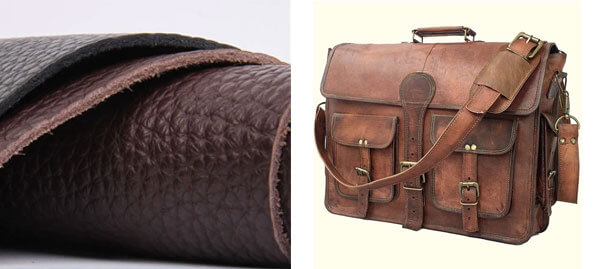
Top grain leather comes from the top layer of the animal hide. It undergoes a process of polishing or buffing to remove surface imperfections. This process also allows for the application of finishes, which makes the leather thinner and more flexible for shaping into handbags or purses. This leather is durable and resistant to damage, making it suitable for long-lasting use.
Similar to full grain leather, top grain leather can also develop a patina. Due to its lower scarcity and production techniques compared to full grain leather, it is less expensive to produce.
Corrected grain leather
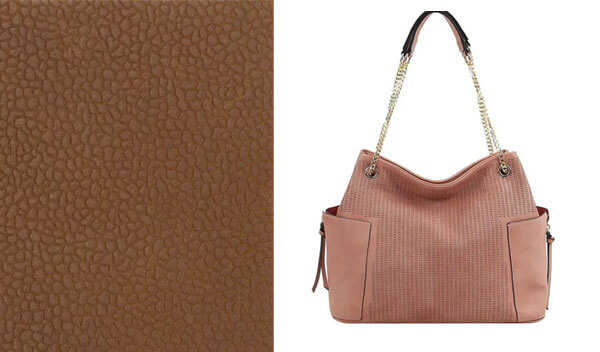
Corrected grain leather is made by repairing and processing the surface of raw animal leather, which is usually of lower quality or has flaws. After the repair process, the flaws can be concealed, and various textures can be created to make it more visually appealing. Additionally, the surface is coated with a protective layer to enhance durability and resistance to dirt. That’s why many tote bags, backpacks, wallets, and laptop bags are made using this material.
Corrected grain leather doesn’t require much cost, but it has average breathability, and the surface may peel or delaminate with long-term use.
Cross grain leather
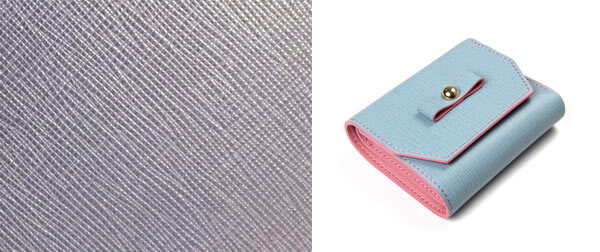
Cross grain leather belongs to embossed leather. It is produced by spraying PVC or PU film onto the surface of the cowhide first. And then it is pressed with a steel plate with a cross-grain texture at a certain temperature to create a pattern resembling a cross. It retains the moisture-absorbing and breathable properties of genuine leather. And it also enhances durability, and water resistance through the coating.
This type of leather has a unique appearance, good strength, and a soft and comfortable feel. It is suitable for making fashionable wallets, crossbody bags, and different handbags. Please note that different manufacturers may use different processing methods and techniques, resulting in variations in the texture.
Above is the classification of different processing methods. Next, I will introduce to you synthetic leathers and leathers made from different animal hides.
Cowhide leather
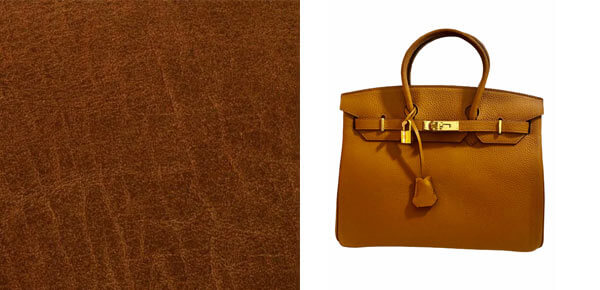
Cowhide leather is the most common type of leather. It is mainly divided into yellow cowhide, buffalo hide, and steer hide. Cowhide has good elasticity and durability, and it possesses natural textures. Meanwhile, it can be dyed in multiple colors and has various finishes to imitate a luxurious style. Cowhide leather can have a smooth, hairy, hard, or soft texture depending on the tanning process.
However, genuine cowhide leather is expensive, and there are many faux leathers that impersonate real ones. So you need to distinguish them when making a purchase.
Goatskin leather
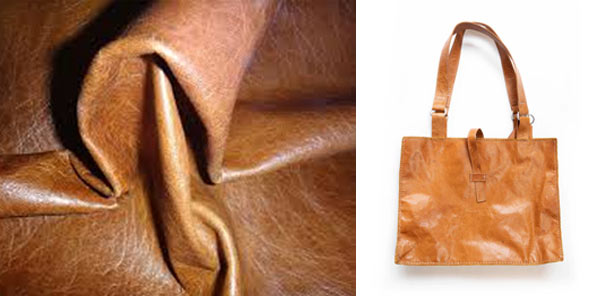
This leather has a light, thin, and soft texture, with good breathability and easy processing. Its structure is strong, so it has good tensile strength. And its thick surface layer makes it resistant to abrasion. This leather also has a certain level of elasticity, making it suitable for making bags that require some deformation and expansion space, such as handbags or backpacks.
However, the surface of goat leather may be slightly rougher than other types of leather.
Pigskin leather
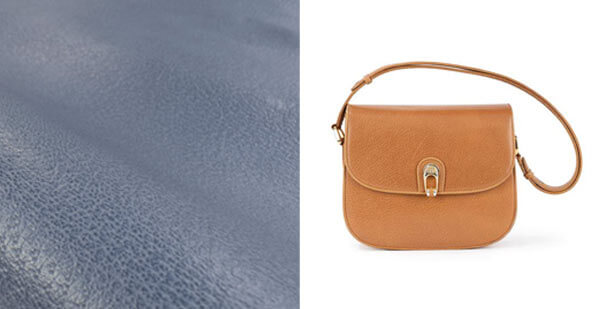
Pigskin leather is thin, durable, and lightweight. It is also not easily worn, with pore patterns on the surface. Pig leather can be divided into grain leather and flesh leather, with grain leather being the most commonly used. Due to the rough surface and coarse pores, grain leather is often subjected to suede treatment to achieve a softer and smoother texture. After treatment, it can also undergo printing, dyeing, and embossing processes to enrich the leather patterns.
The disadvantage of pig leather is that it has an average texture and cannot produce leather as thick as cowhide.
Faux leather
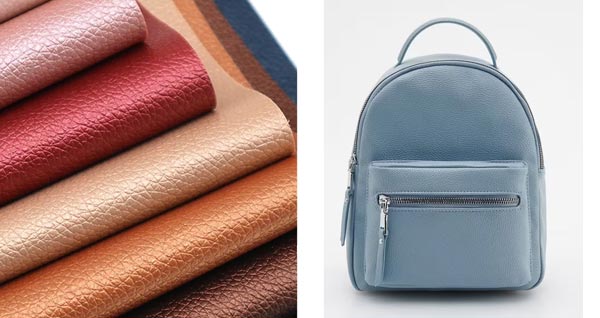
This is a type of synthetic leather that is commonly made using materials such as PU, PVC, PAF, etc. It typically requires surface coating, dyeing, and finishing treatments. So it can mimic the texture and appearance of genuine leather, including glossy, matte, or polished effects. It also has good pliability, suitable for various shapes and designs of bags. Compared to genuine leather, faux leather is usually more affordable, serving as a relatively inexpensive alternative.
However, its durability is not good, making it prone to wear and tear.
Bonded leather
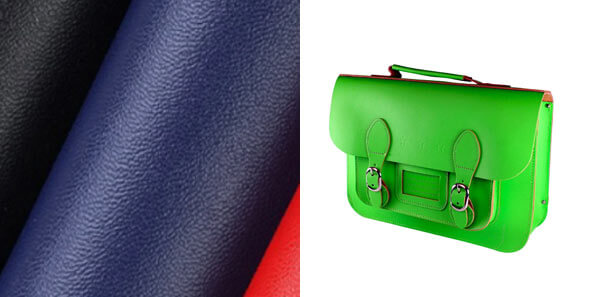
Bonded leather is also a type of artificial leather, made by mixing leather scraps or fibers with glue or other adhesives. It has a similar appearance and feel to genuine leather, but lacks natural beauty. This type of leather can be designed in different colors, textures, and patterns, and it is also affordable.
However, it is prone to wear, fading, and decomposition, and it may have an odor due to the use of adhesives during the manufacturing process.
Crocodile leather
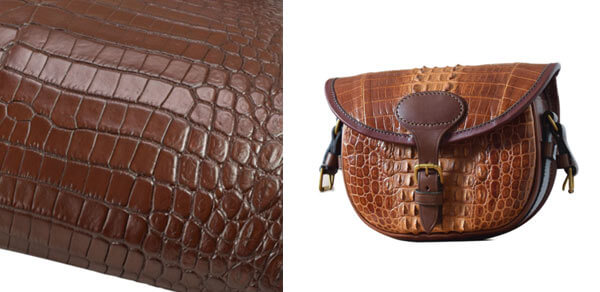
Crocodile skin is considered the most precious one in the leather industry. It is renowned for its top-tier luxury and rarity, given the scarcity and difficulties in breeding crocodiles. This type of leather is highly durable and possesses a distinctive natural crocodile scale texture. Due to its high cost, many e-commerce sellers opt for using other types of leather to create crocodile patterns and enhance the appeal of handbags.
Jingsourcing is a leading sourcing company in China. We have helped dozens of clients source and customize bags in different styles from China.
We are professional in sourcing bags made from different leathers, including natural and faux leather. Also, with 15 years of bag customization experience, we can deal with many complex customizations. In addition, we offer 5-10 days for sampling, and you can keep asking for modifications until the final sample is confirmed. Mass production usually requires 15-25 days. And we can conduct three-time strict quality inspections as required.

Leave A Comment